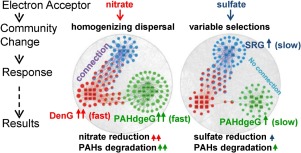当前位置:
X-MOL 学术
›
J. Hazard. Mater.
›
论文详情
Our official English website, www.x-mol.net, welcomes your
feedback! (Note: you will need to create a separate account there.)
Interactions of PAH-degradation and nitrate-/sulfate-reducing assemblages in anaerobic sediment microbial community.
Journal of Hazardous Materials ( IF 12.2 ) Pub Date : 2020-01-10 , DOI: 10.1016/j.jhazmat.2020.122068 Xunan Yang 1 , Enze Li 1 , Feifei Liu 1 , Meiying Xu 1
Journal of Hazardous Materials ( IF 12.2 ) Pub Date : 2020-01-10 , DOI: 10.1016/j.jhazmat.2020.122068 Xunan Yang 1 , Enze Li 1 , Feifei Liu 1 , Meiying Xu 1
Affiliation

|
Nitrate and sulfate are electron acceptors (EAs) for biodegradation of polycyclic aromatic hydrocarbons (PAHs) in anaerobic sediments. The efficiency of PAHs biodegradation depends on the strength of the interactions between PAH-degradation and EA-reduction assemblages. However, these interactions are less studied. In this study, microbial response and PAH degradation efficiencies in river sediment were investigated using nitrate and sulfate stimulation. Results showed that the functional assemblages (PAH-degraders, nitrate- and sulfate- reducers) were low connectivity in the microbial network without EA adding. Nitrate input rapidly (<1 day) raised the nitrate reduction intensity. And the PAH-degraders and nitrate reducers established significant and direct correlations under nitrate stimulation, seen from the 13 connectors (nodes) in the microbial network. In contrast, sulfate reducers slowly increased in abundance (>20 days) and were connected to PAH-degraders through indirect connection under sulfate stimulation. The null model suggested that nitrate led to a higher level of directional selection, which implied that nitrate was a more favorable EA to trigger the deterministic succession. As a result, PAHs degradation was faster with nitrate stimulation (t1/2 = 68.3 d) than with sulfate stimulation (t1/2 = 164.6 d). These mechanistic understandings can serve as the guidelines for EA selection in bioremediation.
中文翻译:

厌氧沉积物微生物群落中PAH降解与硝酸盐/硫酸盐还原组合的相互作用。
硝酸盐和硫酸盐是用于厌氧沉积物中生物降解多环芳烃(PAH)的电子受体(EA)。PAHs生物降解的效率取决于PAH降解和EA还原组合之间相互作用的强度。但是,这些相互作用的研究较少。在这项研究中,使用硝酸盐和硫酸盐刺激研究了河流沉积物中的微生物响应和PAH降解效率。结果表明,在不添加EA的情况下,微生物网络中的功能组合(PAH降解剂,硝酸盐还原剂和硫酸盐还原剂)连接性较低。硝酸盐输入迅速(<1天)提高了硝酸盐还原强度。在硝酸盐刺激下,PAH降解剂和硝酸盐还原剂建立了显着的直接相关性,从微生物网络中的13个连接器(节点)可以看到。相反,硫酸盐还原剂的丰度缓慢增加(> 20天),并在硫酸盐刺激下通过间接连接而与PAH降解剂连接。无效模型表明硝酸盐导致较高的方向选择水平,这意味着硝酸盐是触发确定性继承的更有利的EA。结果,硝酸盐刺激(t1 / 2 = 68.3 d)比硫酸盐刺激(t1 / 2 = 164.6 d)更快地降解了PAHs。这些机制的理解可以作为生物修复中EA选择的指南。无效模型表明硝酸盐导致较高的方向选择水平,这意味着硝酸盐是触发确定性继承的更有利的EA。结果,硝酸盐刺激(t1 / 2 = 68.3 d)比硫酸盐刺激(t1 / 2 = 164.6 d)更快地降解了PAHs。这些机制的理解可以作为生物修复中EA选择的指南。无效模型表明硝酸盐导致较高的方向选择水平,这意味着硝酸盐是触发确定性继承的更有利的EA。结果,硝酸盐刺激(t1 / 2 = 68.3 d)比硫酸盐刺激(t1 / 2 = 164.6 d)更快地降解了PAHs。这些机制的理解可以作为生物修复中EA选择的指南。
更新日期:2020-01-11
中文翻译:

厌氧沉积物微生物群落中PAH降解与硝酸盐/硫酸盐还原组合的相互作用。
硝酸盐和硫酸盐是用于厌氧沉积物中生物降解多环芳烃(PAH)的电子受体(EA)。PAHs生物降解的效率取决于PAH降解和EA还原组合之间相互作用的强度。但是,这些相互作用的研究较少。在这项研究中,使用硝酸盐和硫酸盐刺激研究了河流沉积物中的微生物响应和PAH降解效率。结果表明,在不添加EA的情况下,微生物网络中的功能组合(PAH降解剂,硝酸盐还原剂和硫酸盐还原剂)连接性较低。硝酸盐输入迅速(<1天)提高了硝酸盐还原强度。在硝酸盐刺激下,PAH降解剂和硝酸盐还原剂建立了显着的直接相关性,从微生物网络中的13个连接器(节点)可以看到。相反,硫酸盐还原剂的丰度缓慢增加(> 20天),并在硫酸盐刺激下通过间接连接而与PAH降解剂连接。无效模型表明硝酸盐导致较高的方向选择水平,这意味着硝酸盐是触发确定性继承的更有利的EA。结果,硝酸盐刺激(t1 / 2 = 68.3 d)比硫酸盐刺激(t1 / 2 = 164.6 d)更快地降解了PAHs。这些机制的理解可以作为生物修复中EA选择的指南。无效模型表明硝酸盐导致较高的方向选择水平,这意味着硝酸盐是触发确定性继承的更有利的EA。结果,硝酸盐刺激(t1 / 2 = 68.3 d)比硫酸盐刺激(t1 / 2 = 164.6 d)更快地降解了PAHs。这些机制的理解可以作为生物修复中EA选择的指南。无效模型表明硝酸盐导致较高的方向选择水平,这意味着硝酸盐是触发确定性继承的更有利的EA。结果,硝酸盐刺激(t1 / 2 = 68.3 d)比硫酸盐刺激(t1 / 2 = 164.6 d)更快地降解了PAHs。这些机制的理解可以作为生物修复中EA选择的指南。











































 京公网安备 11010802027423号
京公网安备 11010802027423号